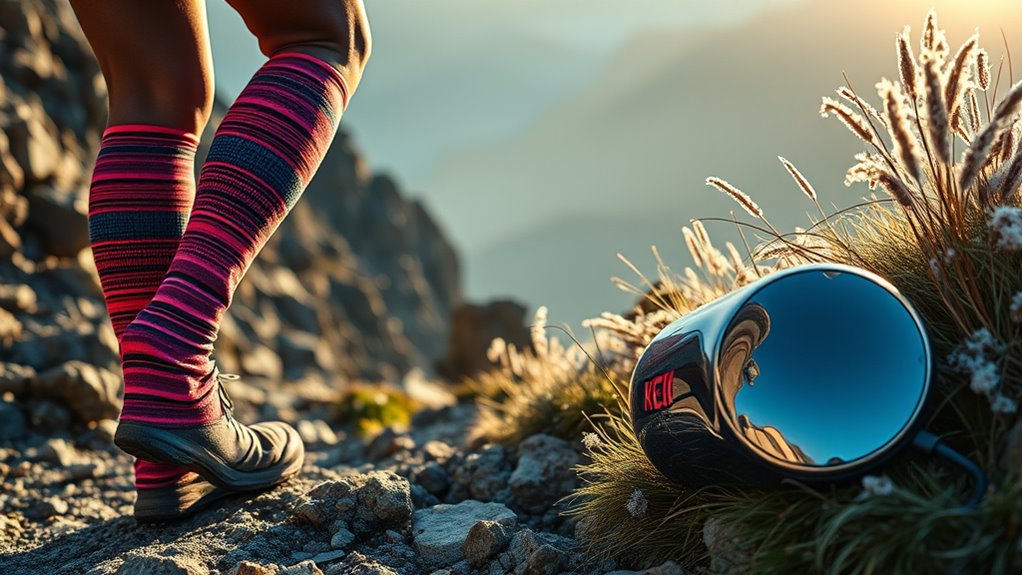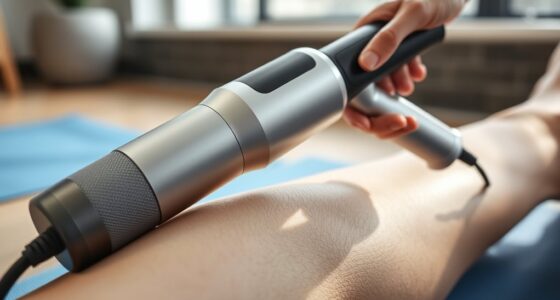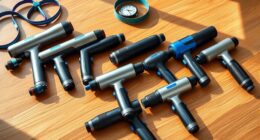Percussion therapy helps mountain climbers prevent cramps by promoting blood flow and relaxing tight muscles after strenuous activity. It breaks down knots and reduces soreness, which is essential at high elevations where dehydration and fatigue increase cramping risks. Using percussion devices on key muscle groups can speed recovery and keep your muscles flexible. By incorporating this technique into your routine, you’ll stay stronger longer—discover more tips that can help you conquer your next ascent.
Key Takeaways
- Percussion therapy enhances blood flow and muscle relaxation, reducing the risk of cramping during mountain climbs.
- It helps break down muscle knots and alleviate tightness caused by strenuous activity at high altitudes.
- Using percussion devices on key muscle groups speeds recovery and prevents soreness that can lead to cramps.
- Regular percussion therapy supports muscles stressed by altitude changes and prolonged exertion.
- Combining percussion with hydration and climate control optimizes muscle health and minimizes cramping risks during climbs.

Mountain climbing puts incredible stress on your muscles, leaving them tight, sore, and prone to injury. To keep your muscles in peak shape and prevent cramping, you need to pay close attention to hydration strategies and altitude adaptation. When you’re ascending to high elevations, your body faces decreased oxygen levels, which can lead to dehydration and fatigue. Proper hydration isn’t just about drinking water; it’s about maintaining electrolyte balance, which helps your muscles function smoothly. Electrolytes like sodium, potassium, and magnesium are essential for nerve signaling and muscle contractions. If you neglect hydration strategies, you risk cramping or even more severe muscle injuries, especially during strenuous climbs. Make sure to hydrate regularly, even if you’re not feeling thirsty, and consider electrolyte supplements or sports drinks designed for altitude conditions. These will help your body adapt more effectively to the increased altitude, reducing the risk of cramping and fatigue.
As you ascend, your body needs to adapt gradually to the changing environment. Altitude adaptation involves allowing your body time to acclimate, which helps prevent altitude sickness and muscle cramps. If you rush your ascent, your muscles may become overly stressed, leading to tightness and cramping. Incorporate rest days into your climbing schedule, and listen to your body’s signals. During this process, percussion therapy can be a game-changer, as it promotes blood flow, relaxes tight muscles, and speeds recovery. Using percussion devices on key muscle groups—like your calves, thighs, and lower back—can alleviate soreness and prevent cramping before it starts. The rhythmic percussive action helps break down knots and increase circulation, which is especially beneficial when your muscles are taxed from altitude adaptation and prolonged exertion. Additionally, choosing equipment with efficient heat pump technology can support climate control, ensuring a comfortable environment that helps your muscles recover faster after strenuous activity.
In addition to percussion therapy, staying proactive with hydration strategies will support your muscles’ health. Proper hydration helps your body regulate temperature, reduce inflammation, and recover faster from strenuous activity. When combined with gradual altitude adaptation, these strategies create a solid foundation that keeps your muscles flexible and less prone to cramping. Remember, mountain climbing isn’t just about reaching the summit; it’s about listening to your body and giving it what it needs to perform at its best. By integrating effective hydration practices with percussion therapy, you can better manage muscle tightness, avoid cramping, and enjoy your climb with less discomfort and more confidence.
Frequently Asked Questions
Can Percussion Therapy Replace Traditional Stretching Before Climbs?
You might wonder if percussion therapy can replace traditional stretching before climbs. While percussion therapy effectively promotes muscle activation and enhances flexibility, it shouldn’t fully substitute stretching. Stretching prepares your muscles for activity, reducing injury risk, whereas percussion therapy can be a great supplement to boost muscle readiness. Combining both ensures ideal flexibility and muscle activation, giving you the best chance to perform well and prevent cramping during your climbs.
How Often Should Climbers Use Percussion Therapy During a Trip?
You should use percussion therapy during your trip based on your activity level and muscle response. For optimal results, consider massage frequency of 2-3 sessions daily, especially after intense climbs or long hikes. Therapy timing is essential—apply it post-exercise to reduce soreness and cramping. Listen to your body, and if muscles feel tight or fatigued, increase the frequency temporarily. Consistency helps prevent cramps and keeps you ready for the next climb.
Are There Specific Percussion Devices Recommended for Mountain Climbers?
When choosing percussion devices for mountain climbing, you should look for mountain-specific devices and portable percussion tools that are lightweight, durable, and easy to carry. These tools should target your muscles, increase circulation, and prevent cramping during your ascent. Opt for compact, rechargeable options designed for outdoor use, ensuring you can maintain muscle health on the go. With the right gear, you’ll stay active, agile, and ready to conquer any challenge.
Is Percussion Therapy Effective for Altitude Sickness Prevention?
You might wonder if percussion therapy helps prevent altitude sickness. While it’s effective for cramp prevention and muscle recovery, there’s limited evidence showing it directly prevents altitude sickness. To reduce your risk, focus on gradual ascents, staying hydrated, and listening to your body. Percussion therapy can support muscle health, but don’t rely on it solely for altitude sickness prevention. Proper acclimatization remains your best strategy.
Can Percussion Therapy Cause Any Adverse Effects During High-Altitude Activities?
You might wonder if percussion therapy has risks involved during high-altitude activities. While generally safe, it can cause minor adverse effects like skin irritation or bruising if not used properly. To guarantee safety, follow recommended safety precautions, such as avoiding sensitive areas and limiting session duration. If you experience discomfort or unusual symptoms, stop use immediately and consult a healthcare professional to prevent potential complications.
Conclusion
So, next time you’re gearing up for a mountain adventure, don’t forget percussion therapy. It’s your secret weapon to banish cramps faster than a lightning strike and keep your muscles happy and ready. With this simple tool, you’ll conquer peaks and challenges like a mountain goat on steroids. Trust me, your muscles will thank you, and you’ll be unstoppable. Embrace percussion therapy, and make cramping a thing of the past—your summit awaits!








